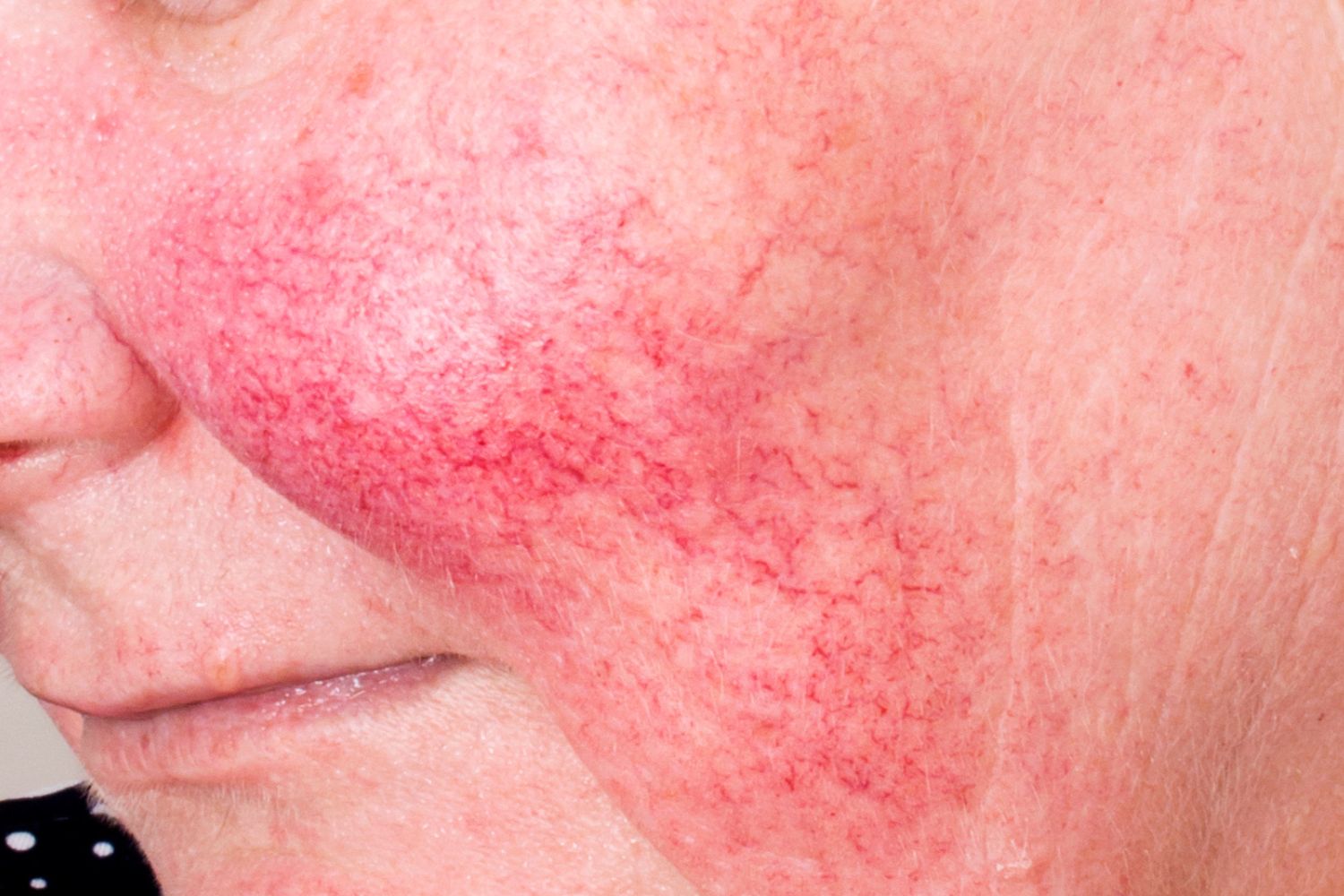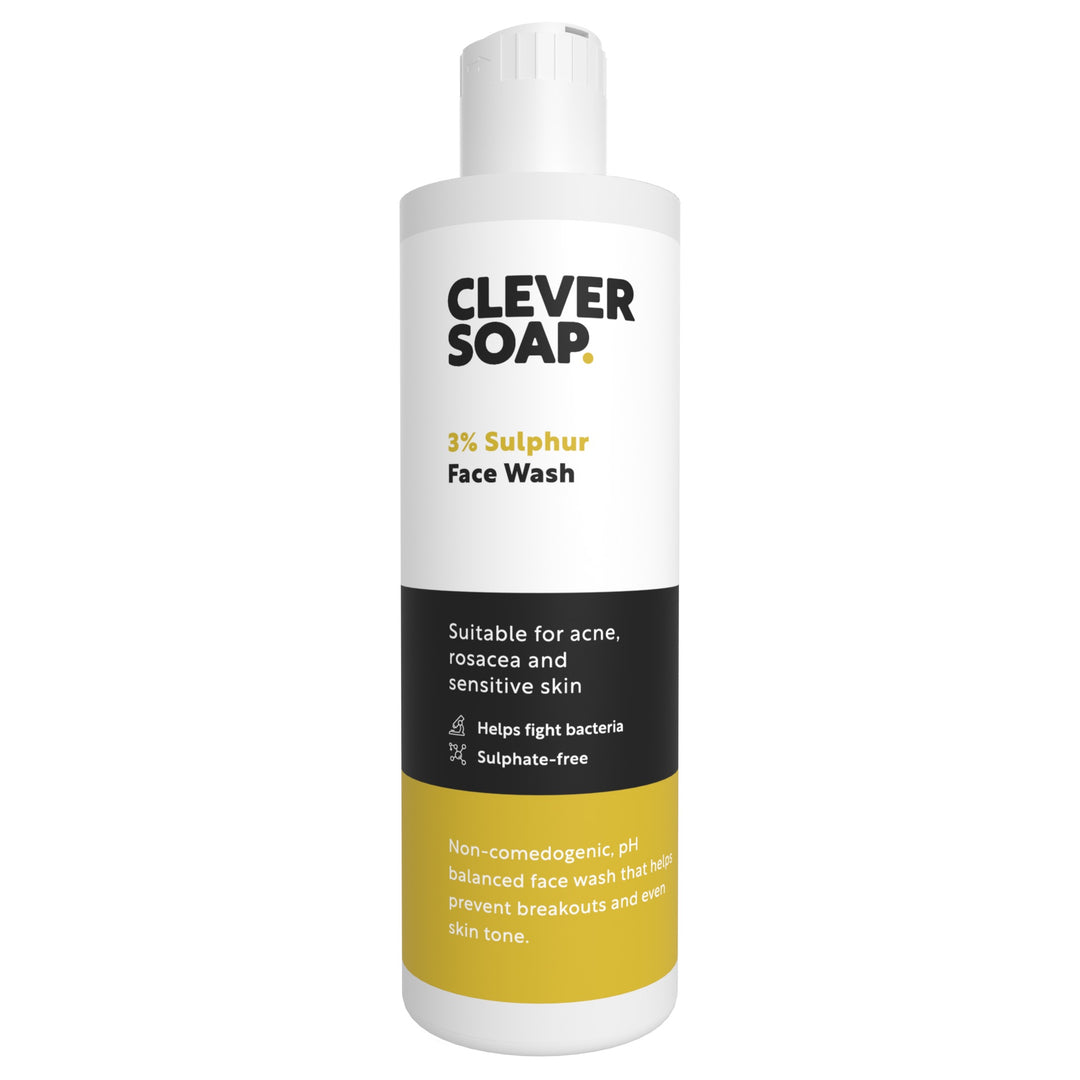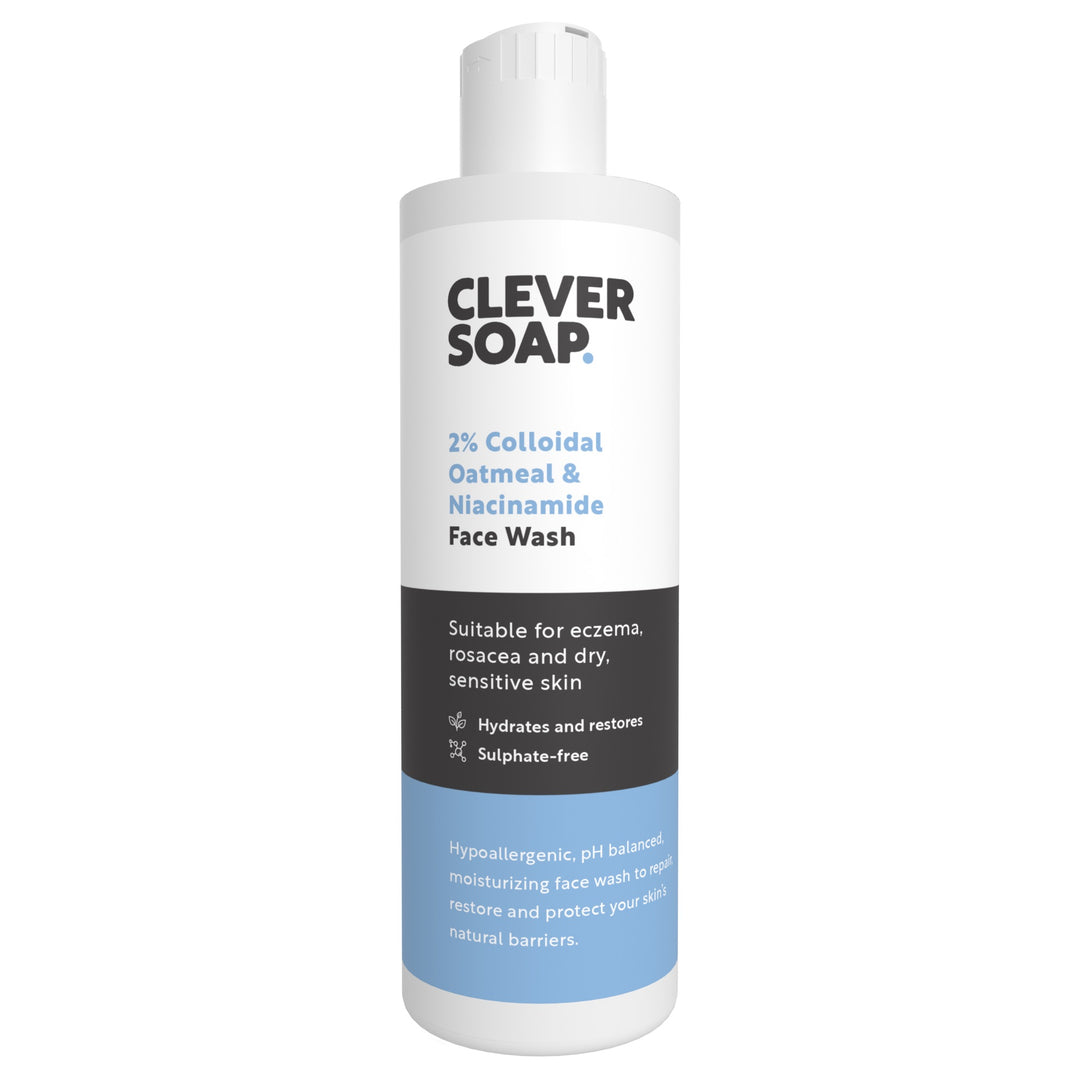U.K. DELIVERY £1.99, FREE FOR ORDERS OVER £25 | INTERNATIONAL DELIVERY FROM £9.99

Rosacea
An Introduction To Rosacea
Rosacea is a common chronic inflammatory skin condition that primarily affects the face, causing symptoms such as erythema (redness), papules (small, raised bumps), and pustules (pus-filled bumps). It’s more prevalent among individuals with fair hair and blue eyes [1].
The exact cause of rosacea remains unknown. However, it is believed to be a result of a combination of hereditary and environmental factors which will be discussed in more detailed later in this article.
While there is currently no cure for rosacea, a variety of treatments are available to help manage symptoms and improve quality of life. These include topical creams, gels and serums with ingredients such as azelaic acid and niacinamide, as well as antibiotics that may be prescribed by a healthcare professional for more severe cases.
It's important to note that the management of rosacea requires a long-term approach and a specific skincare routine, being sure to avoid certain ingredients that may aggravate the condition and worsen symptoms.
Skincare Suitable For Rosacea
These products are both suitable for rosacea; free from sulphates, fragrances and harsh chemicals that may irritate the skin.
What Causes Rosacea?
Like some other skin conditions such as acne, the exact cause of rosacea is not fully understood. It’s believed to be due to a combination of hereditary and environmental factors and despite a common misconception, it is not caused by poor hygiene.
Genetics are likely to play a major role in the contribution of rosacea. A 2015 study of identical and fraternal twins found that about half of the contribution to rosacea could be accounted for by genetics [2].
The same study also found that exposure to UV radiation, alcohol consumption, smoking, and age have been identified as environmental factors that correlate with rosacea. Furthermore, rosacea has been associated with abnormal inflammation and vascular dysfunction. Some studies suggest that rosacea may be linked to the immune system and vascular hyperreactivity [3].
What Are The Main Symptoms Of Rosacea?
Rosacea can cause a number of symptoms, sometimes separately and sometimes altogether. The most common ones are:
Redness. This is the most common symptom of the skin condition and usually presents itself on the face, particularly around the cheeks and nose, but also around the chin and forehead. This redness can show as small blood vessels but also as small, red bumps, sometimes filling with a yellow liquid known as pus. These symptoms may appear only occasionally, or they may be present long-term.
Tender skin. While some people don’t feel any physical discomfort or pain with rosacea, others may notice that their skin is tender, sore and sometimes feels quite hot. This can be made worse when applying certain products to the affected areas, so it’s important to be careful what you use on your skin.
Irritated Eyes. Known as ocular rosacea, for some individuals the eyes can become swollen, dry and irritated. This can be in addition to the effects of rosacea on the skin, or it may be separate.
Irritated Nose. Rosacea can also affect the nose, more commonly in men rather than women, and the skin can toughen up around this area and make it appear larger.
If you’re concerned you may be suffering from rosacea but are unsure, contact your GP who will be able to provide a diagnosis.
Skin Conditions Often Confused With Rosacea
Rosacea vs Psoriasis
Unlike rosacea, psoriasis is an autoimmune condition characterized by a rapid build up of skin cells that can lead to red, scaly patches on the skin; often on the elbows, knees and scalp, although they can appear anywhere on the skin. Rosacea, on the other hand, is an inflammatory skin condition that usually affects the face.
Rosacea vs Eczema
Eczema, also known as atopic dermatitis, can occur anywhere on the body and cause dry, itchy skin. Rosacea is usually found on the face and can also result in papules and pustules. It can also be itchy but this symptom is less common.

Rosacea vs Acne
Like rosacea, acne most commonly appears on the face and can lead to redness and small bumps. It’s caused by the overproduction of oil and the buildup of dead skin cells, and as such treatment is typically different, involving topical medications, antibiotics or hormonal treatments. Some ingredients can be effective for treating both acne and rosacea, however, such as azelaic acid and niacinamide.
How To Treat Rosacea
Although there is no cure for rosacea, there are a number of ways to help manage the condition and reduce symptoms. These tend to fall into two categories.
1. Lifestyle Changes To Improve Symptoms Of Rosacea
It’s important to try and identify and avoid triggers that may cause rosacea flare-ups so that they may be reduced or eliminated. These can include sun exposure, hot or cold temperatures, spicy foods, alcohol, and stress. To help with this, be sure to use sun protection, such as wearing a broad-spectrum sunscreen with an SPF of 30 or higher. Consider making dietary changes if necessary to reduce the intake of spicy foods and alcohol, and find ways to help manage stress.

2. Treatments And Medications For Rosacea
The following ingredients and medications have been shown to help manage and reduce symptoms of rosacea. Some can be found in creams and lotions over-the-counter, whilst others can only be prescribed by a healthcare professional.
Antibiotics. Antibiotics such as metronidazole are commonly used to treat rosacea, helping to reduce inflammation and reduce redness. Antibiotics are usually used for more severe cases of rosacea as they can lead to issues such as antibiotic resistance.
Azelaic acid. This is a naturally occurring acid found in wheat, rye and barley that has been approved by the US Food and Drug administration for the treatment of mild to moderate acne and rosacea. A 2011 study found that treatment twice daily with a 15% azelaic acid gel improved symptoms of rosacea [4].
Ceramides. These are lipids (fats) that are important in maintaining the skin’s barrier and retaining moisture. A 2022 study found that a cream containing ceramides, among other ingredients, resulted in a significant improvement in some patients with rosacea [5].
Laser and light therapies. Laser or intense pulsed light (IPL) treatments can be used to reduce the appearance of visible blood vessels and redness associated with rosacea.
Niacinamide. A type of vitamin B3, this ingredient has anti-inflammatory properties. A 2005 study demonstrated its ability to improve the skin barrier and provide clinical benefits to subjects with rosacea [6].
Sulphur. A natural ingredient that has been used for thousands of years with a low risk of side effects. A recent 2023 study showed similar efficacy to a topical antibiotic, TMP [7]. To understand more about sulphur, check out our handy sulphur guide here.
The Rosacea Blacklist: What To Avoid If You Have Rosacea
It’s important to minimize exposure to, and avoid, some external factors in order to help improve symptoms of rosacea, and be aware of some ingredients found in skincare products that may exacerbate the condition.
External factors that may exacerbate symptoms of rosacea
Hot drinks. Hot drinks, such as coffee and tea, can trigger rosacea flare-ups in some individuals. If hot beverages worsen your symptoms, consider switching to iced or lukewarm alternatives.
Alcohol. Alcohol may act as a trigger for rosacea [8], but isn’t considered a primary cause.
Spicy foods. Spicy foods can trigger rosacea flare-ups in some individuals. Limit or avoid spicy foods if they worsen your symptoms.
Aerobic exercise. Intense physical activity can cause rosacea flare-ups due to increased body temperature and blood flow. Opt for low-impact exercises, such as walking or swimming, and stay cool by exercising in a well-ventilated area or during cooler times of the day.
Intense sunlight. Protect your skin from the sun by wearing a broad-spectrum sunscreen with an SPF of 30 or higher, seeking shade, and wearing protective clothing, such as wide-brimmed hats and sunglasses.
Extreme temperatures. Avoid excessive heat or cold, as they can exacerbate rosacea symptoms. When possible, stay indoors during extreme weather conditions and use a humidifier to maintain indoor humidity levels.
Emotional factors such as stress. Stress can exacerbate rosacea symptoms. Practice stress management techniques, such as deep breathing, meditation, or yoga, to help reduce stress levels.
Common Skincare Ingredients To Avoid If You Have Rosacea
Below are some common skincare ingredients that are best avoided in individuals that suffer from rosacea. It’s important to note that the composition of products that contain these ingredients, and the quantity of each ingredient, should be taken into account.
Fragrances. These can be a common cause of irritation for people with sensitive skin and could be potential triggers for rosacea flare-ups.
Glycolic acid. This is an alpha-hydroxy acid that helps to exfoliate the skin, but it can cause irritation and redness that may worsen symptoms of rosacea.
Lactic acid. This is another alpha-hydroxy acid that can also worsen symptoms of rosacea.
Salicylic acid. This is a beta-hydroxy acid that can be harsh and irritating for individuals with rosacea.
Witch hazel. This is a natural astringent derived from the bark and leaves of the Hamamelis virginiana plant. It may not be well-tolerated by individuals with symptoms of rosacea due to the sensitivity of the skin.
Best Skincare Routine for Rosacea
Managing rosacea requires a gentle and consistent skincare routine focused on calming inflammation, supporting the skin barrier, and avoiding common triggers like harsh ingredients, heat, and friction. Below is a simple, effective routine designed to help keep flare-ups under control and maintain a healthier skin appearance.
Morning Routine
- Gentle Cleanser. Use a mild, non-foaming cleanser that is free from sulfates, fragrance, and alcohol. Look for calming ingredients like green tea extract, colloidal oatmeal or sulphur, which can help soothe visible redness and irritation. Avoid scrubs, exfoliants, and essential oils. Our Sulphur Face Wash is ultra-gentle and suitable for sensitive skin types, including those prone to rosacea, as is our Colloidal Oatmeal Face Wash.
- Calming Serum or Mist (Optional). If your skin feels flushed or reactive in the mornings, a light mist with thermal spring water or a serum containing azelaic acid (low concentration) or centella asiatica may help soothe and reduce redness.
- Moisturizer. Opt for a lightweight, barrier-repairing moisturizer containing ceramides, hyaluronic acid, or squalane. Avoid rich, occlusive products unless your skin is very dry.
- Sunscreen Daily SPF is very important with rosacea. Use a mineral (physical) sunscreen with zinc oxide or titanium dioxide, which are gentler on reactive skin. Choose formulas labeled as non-comedogenic and suitable for sensitive skin. Avoid chemical filters like avobenzone or oxybenzone if they tend to sting.
Evening Routine
- Gentle Cleanse. Use the same non-foaming cleanser to remove dirt and excess oil without disturbing the skin barrier.
- Targeted Treatment (Optional). If prescribed by a dermatologist, apply a topical treatment such as metronidazole, azelaic acid, or ivermectin. For natural options, low concentrations of green tea extract or niacinamide can help reduce visible signs of rosacea and support a calmer complexion.
- Moisturizer. Repeat your morning moisturizer, or if your skin feels dry or tight at night, switch to a slightly richer formula that supports hydration overnight without causing irritation.
Common Myths & Misconceptions Around Rosacea
Rosacea Is Caused By Bad Hygiene
This is not true. It’s a chronic skin condition that’s believed to be caused by hereditary and environmental factors.

Rosacea Is Contagious
No, rosacea is not contagious. You cannot catch it from someone else or pass it on through skin contact, sharing towels, or being in close proximity. Its exact cause isn’t fully understood, but it’s believed to involve a combination of genetics, immune system responses, and environmental triggers.
Only Fair-Skinned People Can Get Rosacea
Although it’s more common in people with lighter skin, rosacea can affect people of all skin types.
Rosacea Is The Same As Acne
These are two very different skin conditions with different causes and symptoms. They usually require different treatments, although some skincare ingredients can be beneficial for both skin conditions. To learn more about acne, click here.
Rosacea FAQs
Can rosacea be cured?
Rosacea is a chronic skin condition, meaning there is currently no known cure. However, with the right skincare routine, lifestyle changes, and medical treatments (such as topical or oral prescriptions), many people are able to manage their symptoms effectively. Identifying and avoiding personal triggers is key to reducing flare-ups and keeping rosacea under control.
What triggers rosacea flare-ups?
Common rosacea triggers include sun exposure, spicy foods, hot drinks, alcohol (especially red wine), stress, extreme temperatures, vigorous exercise, and certain skincare ingredients. Because triggers vary from person to person, it can be helpful to keep a diary to track what worsens your symptoms.
What ingredients should I avoid with rosacea?
People with rosacea often have sensitive skin, so it’s best to avoid ingredients that can cause irritation or flushing. These include alcohol-based products, fragrances, menthol, eucalyptus oil, witch hazel, and physical exfoliants. Opt for gentle, non-comedogenic, fragrance-free products designed for sensitive skin.
Can rosacea affect the eyes?
Yes, ocular rosacea is a subtype that affects the eyes and eyelids. Symptoms can include dryness, redness, burning, stinging, and a gritty feeling in the eyes. In more severe cases, it can lead to complications like corneal damage if left untreated. It’s important to see a doctor if you suspect your eyes are affected.
Does rosacea get worse with age?
Rosacea can gradually worsen over time if left untreated. However, with early diagnosis and consistent care, many people are able to prevent their symptoms from progressing. Seeing a dermatologist and adopting a suitable skincare regimen can help keep rosacea under control and reduce flare-ups.
Can rosacea go away on its own?
Rosacea rarely resolves on its own, especially in adults. While symptoms can come and go, the condition typically requires ongoing care to prevent flare-ups. Consistent skincare, trigger management, and medical treatments can lead to long periods of remission for many individuals.
Conclusion
Rosacea is a chronic skin condition characterized by facial redness, swelling, and small, red, pus-filled bumps. This skin can sometimes be tender to the touch, and can also affect the areas around the eyes and nose. The condition can have a significant impact on a patient's quality of life, causing physical discomfort and potential emotional distress.
The exact cause of rosacea is unknown, but is likely due to a combination of hereditary and environmental factors. Some potential triggers include sun exposure, stress, hot weather, alcohol, spicy foods, and certain skincare products. It's important for individuals with rosacea to identify and avoid specific triggers to help manage the symptoms.
Treatment for rosacea often involves a combination of lifestyle changes, skincare routines, and medical treatments. Lifestyle changes may include avoiding known triggers, using sun protection, and managing stress. Skincare routines should focus on using gentle, non-irritating products that are fragrance-free. Medical treatments may be prescribed by a healthcare professional and can include topical treatments, antibiotics, and procedures such as laser therapy.
Although there is no cure for rosacea, it is possible to manage and reduce symptoms and it’s important to consult with a healthcare professional to help with this.
References
[1] Charlson, P. (2022). An introduction to treating rosacea. Journal of Aesthetic Nursing.
[2] Aldrich, N., Gerstenblith, M., Fu, P., Tuttle, M.S., Varma, P., Gotow, E., Cooper, K.D., Mann, M. and Popkin, D.L. (2015). Genetic vs Environmental Factors That Correlate With Rosacea. JAMA Dermatology, 151(11), p.1213. doi:https://doi.org/10.1001/jamadermatol.2015.2230.
[3] Aponte, J.L., Chiano, M.N., Yerges-Armstrong, L.M., Hinds, D.A., Tian, C., Gupta, A., Guo, C., Fraser, D.J., Freudenberg, J.M., Rajpal, D.K., Ehm, M.G. and Waterworth, D.M. (2018). Assessment of rosacea symptom severity by genome-wide association study and expression analysis highlights immuno-inflammatory and skin pigmentation genes. Human Molecular Genetics, [online] 27(15), pp.2762–2772. doi:https://doi.org/10.1093/hmg/ddy184.
[4] McFalda, W.L. and Roebuck, H.L. (2011). Rational management of papulopustular rosacea with concomitant facial seborrheic dermatitis: a case report. The Journal of Clinical and Aesthetic Dermatology, [online] 4(1), pp.40–42. Available at: https://pubmed.ncbi.nlm.nih.gov/21278898/ [Accessed 3 Dec. 2023].
[5] Bedi, G., & Dash, P. (2022). Open label, single arm, interventional multi-centered study to evaluate the efficacy and biophysical response of topical Soteri Skin cream in following skin conditions: atopic dermatitis, eczema, psoriasis and rosacea. International Journal of Research in Dermatology.
[6] Draelos, Z.D., Ertel, K. and Berge, C. (2005). Niacinamide-containing facial moisturizer improves skin barrier and benefits subjects with rosacea. Cutis, [online] 76(2), pp.135–141. Available at: https://pubmed.ncbi.nlm.nih.gov/16209160/.
[7] Yoshimasa Nobeyama, Yoshiko Aihara, and Akihiko Asahina. 2023. “Real-World Evidence for the Treatment of Rosacea with Sulfur or Metronidazole Preparation in Japanese Patients.” JMA Journal 6 (4). https://doi.org/10.31662/jmaj.2023-0100.
[8] Weiss, E. and Katta, R. (2017). Diet and rosacea: the role of dietary change in the management of rosacea. Dermatology Practical & Conceptual, 7(4), pp.31–37. doi:https://doi.org/10.5826/dpc.0704a08.


